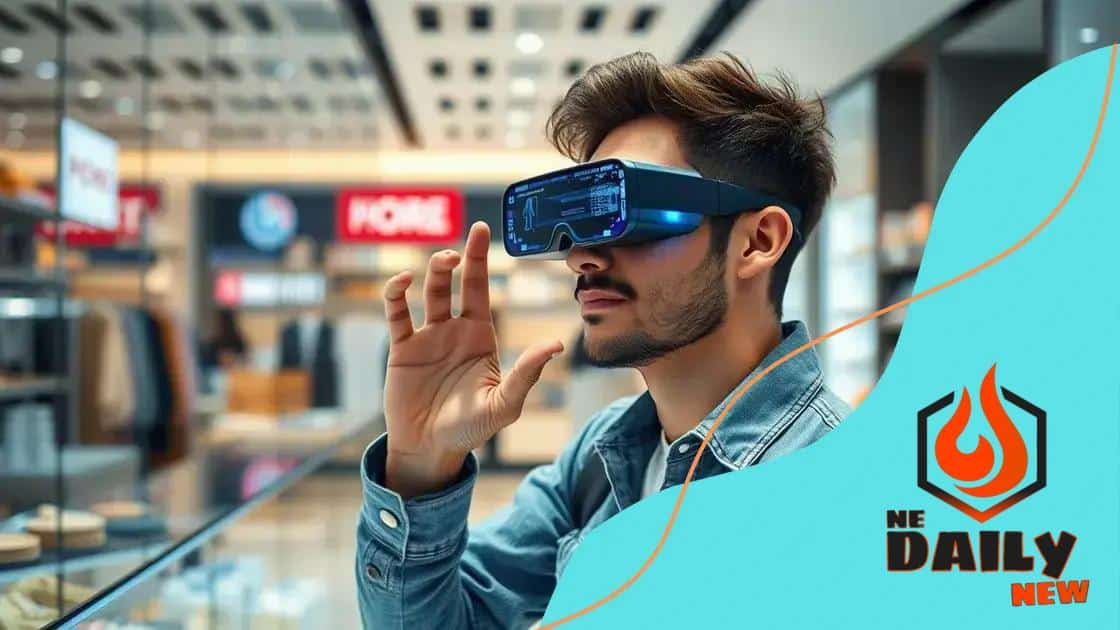How augmented reality is transforming the shopping experience

Augmented reality is transforming the shopping experience by allowing customers to visualize products in their own environment, enhancing engagement, reducing returns, and paving the way for future trends in retail technology.
How augmented reality is transforming the shopping experience is an interesting subject. Ever wondered how shopping could be more interactive? Let’s dive into an exciting world where technology meets retail, making your shopping trips more engaging.
Understanding augmented reality in retail
Understanding augmented reality in retail opens up a world of possibilities for how consumers interact with products. This technology enhances the shopping experience by blending digital elements with the physical world. Imagine being able to try on clothes virtually or visualize how furniture will look in your home, all from the comfort of your device.
What is augmented reality?
Augmented reality (AR) refers to the technology that overlays digital information onto the real world. Unlike virtual reality, which creates complete immersion in a digital environment, AR enhances your current view. This makes it particularly useful for retail, where seeing the product in context can lead to better purchasing decisions.
Benefits of AR in retail
- Improved customer engagement through interactive shopping experiences.
- Increased conversion rates as customers feel more confident in their choices.
- Reduction in product returns by allowing customers to see items in real-time before purchase.
This technology is not just about innovation; it’s about enhancing customer satisfaction as well. By using AR, retailers can create a fun and interactive atmosphere that attracts consumers. This shift is crucial in today’s digital age, where consumers crave engaging and personalized shopping experiences.
With the rise of smartphones and tablets, AR has become more accessible than ever. Retailers need to adapt to these changes, utilizing AR to stand out in a competitive market. It’s about giving customers the tools to visualize their purchases better, leading to a stronger connection with the products.
Enhancing customer experience with AR
Enhancing the customer experience with augmented reality (AR) is a game-changer for retailers. This technology allows customers to interact with products in innovative ways, leading to a more engaging shopping journey. Imagine being able to see how a pair of shoes looks on you without ever stepping into a store!
How AR improves customer interaction
When customers use AR, they get a sense of connection to the product. This connection can elevate the overall shopping experience significantly. Engaging with items in a virtual environment gives customers the confidence they need to make purchases.
Key benefits of AR for customers
- Interactive experiences that make shopping more enjoyable.
- Personalized recommendations based on user preferences and needs.
- Allows customers to visualize products in their own space.
Moreover, AR provides detailed product information in real-time. While shopping, customers can learn about the features and benefits of items, ensuring they make informed decisions. This transparency builds trust and encourages repeat business, ultimately benefiting retailers as well.
As technology continues to evolve, the integration of AR into retail strategies will shape how customers shop. By offering interactive tools, brands can create memorable experiences that keep consumers coming back for more.
How AR is changing product visualization

How AR is changing product visualization is essential for understanding its impact on retail. Augmented reality allows customers to see products in a whole new light. With AR, shoppers can visualize items in their homes or on themselves, making it easier to make purchase decisions.
Transforming the shopping journey
Using AR, customers can experience interactive product displays. For example, they can view a couch in their living room through their smartphone camera. This real-time visualization helps customers understand how products fit into their lives.
Key advantages of AR in product visualization
- Offers an immersive shopping experience that increases customer satisfaction.
- Reduces uncertainty by providing a clear view of how products look in context.
- Enhances engagement by allowing users to customize and modify products digitally.
Moreover, AR helps retailers showcase their products creatively. Imagine a customer trying on makeup virtually or adjusting the size and color of shoes before buying. This technology demystifies the purchasing process, making it feel personalized and tailored to individual preferences.
As augmented reality continues to evolve, it revolutionizes how we perceive products. Retailers adopting AR technologies stand to benefit from enhanced customer loyalty and higher conversion rates. Providing customers with these visual tools not only improves the experience but also fosters a deeper connection with the brand.
The role of AR in reducing returns
The role of AR in reducing returns is crucial in today’s retail landscape. By allowing customers to visualize products before they buy, augmented reality minimizes uncertainty. This technology helps shoppers feel more confident in their choices, leading to fewer returns.
How AR impacts purchase decisions
When customers use AR, they see products in a realistic context. This helps them understand how items fit into their lives. For example, a customer can check how a piece of furniture looks in their living room, significantly impacting their buying decisions.
Benefits of AR in reducing returns
- Improved product visualization decreases mismatched expectations.
- Increased satisfaction leads to better customer loyalty.
- Better fit information helps customers choose the right size and style.
Additionally, AR provides detailed product information, making it easy for customers to get answers about size, materials, and features. This access to essential details helps them make informed decisions and reduces the likelihood of needing to return items.
Retailers implementing AR can also track user interactions. By analyzing how consumers engage with augmented reality tools, they can improve product offerings and websites. This ensures customers have relevant information, leading to a more enjoyable shopping experience.
Future trends in augmented reality shopping
Future trends in augmented reality shopping are exciting and hold great potential for the retail industry. As technology advances, AR experiences will become even more immersive and user-friendly. Retailers will continue to explore innovative ways to enhance the shopping journey and engage customers.
Evolution of AR technology
The future will see improvements in AR hardware and software, allowing for deeper integration into everyday shopping. Devices will become lighter and more accessible, enabling customers to use AR seamlessly. For instance, smartphones and smart glasses will provide enhanced visualizations without needing complicated setups.
Key trends to watch
- Personalized shopping experiences through AR, tailored to individual preferences and shopping behavior.
- Integration with social media platforms, allowing users to share their AR experiences with friends and family.
- Use of AI in conjunction with AR to provide instant recommendations based on user actions.
Additionally, we will see a rise in more realistic AR simulations. Retailers will incorporate environmental factors, such as lighting and space dimensions, making virtual tries-ons feel authentic. This advancement not only improves user experience but also builds trust in the products being offered.
The integration of AR into the overall shopping ecosystem will make it easier for customers to move between online and physical stores. Retailers who invest in these technologies stand to gain a competitive edge, as they will offer unparalleled shopping experiences that meet the needs of the modern consumer.
FAQ – Frequently Asked Questions about Augmented Reality in Shopping
How does augmented reality improve the shopping experience?
Augmented reality allows customers to visualize products in real-time, helping them make informed choices and increasing satisfaction.
Can AR help reduce product returns?
Yes, by enabling customers to see how products fit into their lives, AR reduces uncertainty and leads to more confident purchasing decisions.
What are some trends in augmented reality shopping?
Trends include personalized shopping experiences, integration with social media, and advancements in AR technology for better usability.
Is AR technology becoming more accessible for retailers?
Absolutely! As technology advances, AR tools are becoming easier and more affordable for retailers to implement, enhancing the overall shopping experience.





